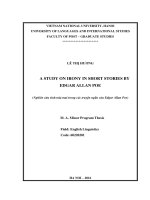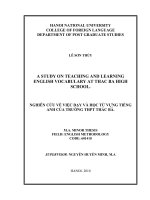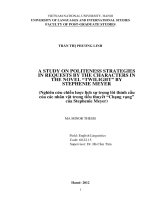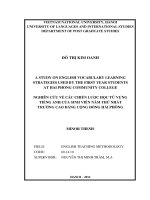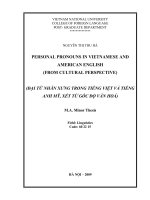(Luận văn thạc sĩ) a study on conceptual metaphors in economic reports in the new york times from the perspective of cognitive liguistics
Bạn đang xem bản rút gọn của tài liệu. Xem và tải ngay bản đầy đủ của tài liệu tại đây (649.54 KB, 87 trang )
VIETNAM NATIONAL UNIVERSITY, HANOI
UNIVERSITY OF LANGUAGES AND INTERNATIONAL STUDIES
FACULTY OF POST-GRADUATE STUDIES
***
TRIỆU KHÁNH TOÀN
A STUDY ON CONCEPTUAL METAPHORS
IN ECONOMIC REPORTS IN THE NEW YORK TIMES
FROM THE PERSPECTIVE OF COGNITIVE LINGUISTICS
NGHIÊN CỨU ẨN DỤ Ý NIỆM TRONG CÁC BÀI BÁO
VỀ KINH TẾ TRÊN TẠP CHÍ NEW YORK TIMES
DƯỚI GĨC NHÌN CỦA NGÔN NGỮ HỌC TRI NHẬN
M.A. MAJOR PROGRAMME THESIS
Field
: English Linguistics
Code
: 60.220.201
Supervisor
: Dr. Phạm Thị Thanh Thùy
HANOI - 2016
CERTIFICATION OF ORIGINALITY
I hereby certify that the thesis entitled ―A Study on Conceptual
Metaphor in Economic Reports in the New York Times from the
Perspective of Cognitive Linguistics‖ is my own study in the fulfillment of
the requirement for the Degree of Master of Arts at Faculty of PostGraduate Studies, University of Languages and International Studies,
Vietnam National University, Hanoi.
Hanoi, 2016
Triệu Khánh Toàn
i
ACKNOWLEDGEMENT
For the completion of this thesis, I have been fortunate to receive
invaluable support from many people. First and foremost, I would like to
express my sincere thanks to my supervisor, Dr. Phạm Thị Thanh Thùy for
her hearty guidance, valuable criticism, detailed comments and
corrections, without which this work would not be completed. My thanks
also go to all my instructors in my M.A. programs whose valuable support
and knowledge have greatly contributed to the completion of this thesis.
Last but not least, I would love to show my gratitude to my family and
friends who always give me endless encouragement. Without all of them,
this thesis can hardly be fulfilled.
ii
ABSTRACT
This paper critically analyses conceptual metaphors used in
economic reports in the New York Times (2013-2014) from the
perspective of cognitive linguistics. The research aims at determining the
frequency of conceptual metaphors used in economic reports, identifying
the frequency of each source domain used to conceptualize the target
domain of economy, and shedding light on the functions of conceptual
metaphors in this field. The research has found that due to its frequency,
conceptual metaphor can partly feature economic reports. Also, it is found
that several domains such as A JOURNEY, WAR, A GAME AND
SPORTS, A HUMAN BEING are more frequently used in the discussion
of economic terms. Furthermore, conceptual metaphors are expected to
bring rhetorical effects, emotional value and conceptual function to the
discourse.
iii
TABLE OF CONTENTS
CERTIFICATION OF ORIGINALITY ............................................................................................. i
ACKNOWLEDGEMENT ................................................................................................................. ii
ABSTRACT ...................................................................................................................................... iii
TABLE OF CONTENTS .................................................................................................................. iv
LIST OF TABLES ............................................................................................................................ vi
PART A: INTRODUCTION ............................................................................................................. 1
1.
Rationale ................................................................................................................................ 1
2.
Objectives and scope of the study .......................................................................................... 4
2.1.
Objectives of the study ................................................................................................... 4
2.2.
Scope of the study .......................................................................................................... 5
3.
Significance of the study ........................................................................................................ 5
4.
Research methodology ........................................................................................................... 6
5.
4.1.
Research questions ......................................................................................................... 6
4.2.
Research approach ......................................................................................................... 7
4.3.
Data collection and analysis ........................................................................................... 7
Design of the study................................................................................................................. 8
PART B: DEVELOPMENT ............................................................................................................ 10
CHAPTER 1: THEORETICAL BACKGROUND ...................................................................... 10
1.1.
Cognitive linguistics..................................................................................................... 10
1.2.
Metaphors..................................................................................................................... 11
CHAPTER 2: LITERATURE REVIEW .................................................................................... 20
2.1. Study on conceptual metaphors ........................................................................................ 20
2.2. Study on conceptual metaphor in economic discourse ..................................................... 23
CHAPTER 3: RESEARCH METHODOLOGY ......................................................................... 26
3.1. Research questions ............................................................................................................ 26
3.2. Research methodology ...................................................................................................... 27
3.2.1. Data and data collection ................................................................................................. 27
3.3. Research procedures ......................................................................................................... 30
CHAPTER 4: FINDINGS AND ANALYSIS ............................................................................. 32
iv
4.1. Frequency of conceptual metaphors denoting ECONOMY in economic reports on New
York Times .............................................................................................................................. 32
4.2. Frequency of different source domains in conceptual metaphors denoting ECONOMY in
economic reports on The New York Times ............................................................................. 37
4.3. Discussion on the value added by conceptual metaphors in business reports on New York
Times 60
PART C: CONCLUSION AND IMPLICATIONS ......................................................................... 66
1.
Research findings ................................................................................................................. 66
2.
Implications .......................................................................................................................... 68
3.
2.1.
Implications for translation and teaching translation ................................................... 68
2.2.
Implications for teachers and students ......................................................................... 70
Limitations and suggestions for further study ...................................................................... 71
3.1.
Limitations ................................................................................................................... 71
3.2.
Suggestions for further study ....................................................................................... 72
REFERENCES................................................................................................................................. 74
APPENDIX 1 ................................................................................................................................... 78
List of economic reports from the New York Times ......................................................................... 78
APPENDIX 3 ................................................................................................................................... 80
QUESTIONNAIRE ......................................................................................................................... 80
v
LIST OF TABLES
The mappings of conceptual metaphor LOVE IS A
Table 1
JOURNEY
Table 2
The number of titles with conceptual metaphors
2
31
The frequency of conceptual metaphors denoting
Table 2
ECONOMY in the main part of economic reports on The
34
New York Times
Table 4
The number and percentage of conceptual metaphors
36
denoting ECONOMY with different source domains
Table 5
reasons for preference of the sentences with
metaphorical expression
vi
58
PART A: INTRODUCTION
1. Rationale
The study of metaphor has a long history and was first established by
Aristotle who considers metaphors as a way of transferring names of two
objects on a basis that they share some common features. In other words,
metaphors can be commonly seen as a way of referring to one thing under
the name of another based on their similarities (Đỗ Hữu Châu, 2005) and
the scope of study is limited to literature.
Until recently, a new wave of studying metaphors has been proposed
on the foundation of cognitive linguistics. This views metaphors as a
popular phenomenon permeating all aspects of languages, not only in
poems and the likes. The concept of conceptual metaphor has been
introduced then. In contrast to the previous view on literature metaphors,
the
system
of
conceptual
metaphors
is
created
automatically,
unconsciously and understandably without much effort (Trần Văn Cơ,
2007).
Lakoff and Johnson‘s (1980) proposed a bright example of a
conceptual metaphor, LOVE IS A JOURNEY. This conceptual metaphor
is made up of a fixed set of well-established mappings, which is illustrated
in the table below:
1
Source domain: JOURNEY
mappings
Target domain: LOVE
TRAVELLERS
LOVERS
VEHICLE
LOVE RELATIONSHIP
JOURNEY
EVENTS IN THE RELATIONSHIP
OBSTACLES ENCOUNTERED
DIFFICULTIES EXPERIENCED
DECISIONS ABOUT
CHOICES ABOUT WHAT TO DO
GOALS OF THE RELATIONSHIP
DIRECTION
DESTINATION OF THE
JOURNEY
Table 1: The mappings of conceptual metaphor LOVE IS A JOURNEY
Obviously, the more concrete domain of JOURNEY helps structure
ideas belonging to the target domain of LOVE. Furthermore, Lakoff and
Johnson (1980) also argue that knowledge of the sort specified by the
conceptual metaphor is necessary for the creation and comprehension of
conceptual metaphors. That is to say, without such knowledge and
previous experience, one would not be able to understand some concepts
of the more abstract domain LOVE (Lakoff &Johnson, 1980).
Similarly to the example proposed by Lakoff, many other cases of
metaphors have been studied, contributing to the comparisons of
metaphorical mechanism between two languages. In Vietnam, Nguyễn Thị
Kim Anh (2014) takes a deep look at the conceptual metaphor
MARRIAGE IS A JOURNEY, which aims at facilitating the teaching of
cultural aspects in foreign language teaching.
2
With the same purpose, an investigation into conceptual metaphors
for life, death, and time in Vietnamese and English has been conducted by
Nguyễn Thị Tú Trinh (2010).
One of the most favored target domains to be described through
source domains is economy. It is admitted that, the world economy has
never failed to win people‘s attention though it has undergone numerous
ups and downs in the last few decades. Hence, the economic reports in
newspapers, journals and magazines have proved themselves to be an
essential part of the daily life. For this reason, certain linguistic features
are taken into great consideration in the production of reports and articles
so that ideas can be effortlessly perceived in such an abstract and abstruse
field. Metaphor, one of the linguistics features, commonly occurs in
economic reports for the reason that metaphors facilitate readers‘
understanding of the abstract domains by means of the concrete domains
(Köveces, 2002).
Within the business domain, conceptual metaphors are supposed to
be of great popularity since the more abstract domain of economy should
be conceptualized by a number of more concrete domains. For example,
we usually see such a metaphoric expression as seeing just one way for
Greece to go: up (The New York Times, 2014). The example illustrates
the use of the concrete domain of JOURNEY to structure ideas belonging
to the domain of ECONOMY. Studies on such use of metaphoric
expressions have been of certain extensiveness. Silva Bratož (2004)
conducts a comparative study of metaphor in English and Slovene used in
popular economic discourse. The study aims to figure out the domains
used business reports in both languages to conceptualize the domain of
economy. Similarly, Black and Ennis (2001) carry out another study of
3
conceptual metaphors between English and Spanish in financial reporting
mainly about stock market crash. According to the findings, there are not
only many similarities but also differences in frequently used metaphors
between two languages. Bai Jinhong (2010) also carries out a study on
conceptual metaphor exploited in the journal Business Week and the
newspaper The New York Times although the study is confined to the
headlines only.
The review of previous studies has encouraged the writer to conduct
further research on conceptual metaphors used in English articles so that
the source domains can be found, and the most frequently used domain can
be identified. In short, it is worth analyzing metaphors in economic reports
to figure out how they work in this field and to categorize other concrete
source domains that are normally used to conceptualize the target domain
of economy.
2. Objectives and scope of the study
2.1.
Objectives of the study
This study primarily concentrates on the metaphors used in economic
reports. Its aim is to have an insight into how metaphors are correlated to
human physical experience and constructed in economic reports. In
addition, the analysis of this correlation will set foundation for later
categorization of the source domains which are exploited in the metaphors
in these economic reports.
4
2.2.
Scope of the study
The research on metaphoric expressions has a long history with
different standpoints. In the traditional view, metaphors should be
regarded as a figure of speech and those metaphoric expressions are
expected to appear in poetry and literary works for rhetorical aims and are
far from use in communication. The second view on metaphor emerged in
1980 and was marked by the publication of Metaphors, We Live By,
written by Lakoff and Johnson. The approach they suggested, known as
the cognitive linguistics view of metaphors, posed a real challenge to the
traditional view since they propose that metaphor exists not only in
language but also in action and thought (2003). Among two views briefly
discussed above, this study takes the latter since economic reports, the
subject of this study, should not be treated as literary works but part of
human communication.
Since its introduction, many cognitive studies of metaphor have been
conducted in politics, sports, economy and many other aspects. This paper
does not expect to cover all those aspects of life, and only conceptual
metaphors found in economic reports are analyzed. Despite the abundance
of economic magazines and journals, this paper focuses only on the
articles from the New York Times posted in 2013.
3. Significance of the study
With this study, the writer strives to make a little theoretical and
practical contribution. Firstly, as part of his endeavor, this paper is
expected to provide an insight into how metaphor works in the field of
economy, which is to add some value to the theory of metaphor from the
5
perspective of cognitive linguistics. The findings and analysis of
metaphors in economic reports also prove the statement made by Lakoff
and Johnson (1980, 1999) that metaphors are conceptual as many of the
ways in which we think and act are basically metaphorical and that
metaphors are not confined to literal works only.
Secondly, for writers of journals, newspapers and magazines, this
study is to provide a practical analysis on how metaphors work and how
they are constructed in economic reports. They are, hence, encouraged to
exploit this linguistic feature so that ideas can be presented in a
comprehensible manner. That is to say, the writer looks forward to
bringing something beneficial to economic reporters in their attempts to
win readers‘ interest.
Finally, this research is also expected to prove the significance of
conceptual metaphors in business reports and to come up with a system of
common domains used to describe the abstract domain of economy.
Hence, translators, teachers, and students of English will be provided with
one of the guideline aiming at native-like use of language in a specific
discourse
4. Research methodology
4.1.
Research questions
An investigation into metaphors in business reports aims at shedding
light on these three questions:
Question 1: How frequently is conceptual metaphor exploited in business
reports in The New York Times?
6
Question 2: What are the most frequently used source domains used to
conceptualize the target domain of economy?
Question 3: What is the value that metaphors used in business reports in
The New York Times adding to the reports?
4.2.
Research approach
This research approaches metaphor from the perspective of cognitive
linguistics. In this view, metaphors are conceptual and many of the ways
in which we perceive and act are basically metaphorical (Evans and Green,
2006), and the source domain serves as the background for structuring and
understanding the target domain (Langacker, 1987).
The study is of both qualitative and quantitative approaches. Firstly,
the study involves the collecting, categorizing and counting metaphorical
expressions quantitatively in the articles. Secondly, the additional value of
metaphoric expressions will be analyzed qualitatively. Furthermore, the
method of direct interview is also applied among economists to decide the
value added by conceptual metaphors.
4.3.
Data collection and analysis
This research is conducted mainly based on the primary data
collected from economic reports of The New York Times and can be
divided into three stages.
The first stage involves the collection of reports, which is to provide
some data for the next stage. To ensure the up-to-date-requirements, the
chosen reports should be released in 2013 and 2014 including such fields
as banking and finance, marketing, investment, human resources, financial
7
public management and so on. The reports should be varied in terms of
topics and authors so that a complete investigation can be achieved.
The second stage develops on the data from the first step and is to
answer the first two research questions. In this stage, metaphors are
identified from those reports. Afterwards, those metaphors will be
categorized and the frequency of metaphors will be determined. First, the
frequency of metaphors in English articles will be the average frequency
of metaphors in each article. The frequency of metaphors in each article is
determined by dividing the number of metaphors by the number of words
per article. Secondly, the frequency of different domains will be
determined by dividing the number of metaphorical expressions of each
domain by the total number of metaphorical expressions identified from
the articles.
The third stage involves the qualitative analysis of additional value
of using metaphorical expressions. The analysis should base on
comparisons between the texts with and without metaphorical expressions.
This analysis should be based on specific cases of metaphorical
expressions taken from the articles.
5. Design of the study
The study will be constructed as follow:
PART 1: INTRODUCTION
In this part, rationale, aims and objectives of the study, scope of the
study are expected to be presented.
8
PART 2: DEVELOPMENT
Chapter 1: Theoretical background and literature review
In this chapter, the writer is supposed to deeply discuss such basic
concepts of metaphors in cognitive linguistics as types of metaphors,
mappings and image schemas. Moreover, previous studies on the same
issue should be presented at length so that the readers and the writer can
reach an agreement on what has been achieved in this field.
Chapter 2: Research methodology
This chapter includes the methods which are exploited in this study
as well as a discussion on the reason for choosing the methods
Chapter 3: Data collection and analysis
In addition, the writer also discusses sources of data, how the data
should be selected and the analytical framework to analyze them.
Chapter 4: Findings
This chapter deals with presenting the findings from the work of data
analysis above, including the presentation of frequency of metaphors in
economic reports and main categories of source domains in those
metaphoric expressions.
PART 3: CONCLUSION
In this part, the writer attempts to summarize the main points in this
study. Also, some limitations should be identified and implications for
application of the results and for further studies are pointed out.
9
PART B: DEVELOPMENT
CHAPTER 1: THEORETICAL BACKGROUND
1.1.
Cognitive linguistics
Cognitive Linguistics discussed in this paper refers to the approach
to the study of language that started its emergence in the 1970s and has
gain most of its increasing popularity since the 1980s. More than a quarter
century later, a massive amount of study has been generated under the
light of cognitive linguistics, most of which has a strong focus on
semantics. However, a considerable proportion is also devoted to syntax
and morphology, and other areas of linguistics are also researched into
under the view of cognitive linguistics, such as language acquisition,
phonology, and historical linguistics.
One of the important assumptions shared by all of these scholars is
that meaning is so central to language that it must be a primary focus of
study. Three major hypotheses as guiding the cognitive linguistic approach
to language are pointed out (Croft, W. & Cruise, D. A., 2004):
Language is not an autonomous cognitive faculty
Grammar is conceptualization
Knowledge of language emerges from language use
The first hypothesis is that language is not an autonomous cognitive
faculty. Consequently, the representation of linguistic knowledge is
essentially the same as the presentation of other conceptual structures, and
that the processes in which that knowledge is used are not fundamentally
10
different from cognitive abilities that human beings use outside the domain
of language.
The second major hypothesis of the cognitive linguistic approach is
embodied in Langacker‘s slogan (1987) ‗grammar is conceptualization.‘ A
major aspect of human cognitive ability is the conceptualization of the
experience to be communicated.
The third major hypothesis of the cognitive linguistic approach is
that knowledge of language emerges from language use. That is to say,
categories and structures in semantics, syntax, morphology and phonology
are built up from our cognition of specific utterances on specific occasions
of use.
1.2.
Metaphors
1.2.1. Traditional views on metaphors
There have been a number of linguistic scholars making a real
attempt to provide a definition of metaphors. This part is to review several
noticeable definitions of linguistic metaphors according to traditional
views.
Firstly, Aristotle (1954) should be first mentioned since he provides
us with the first extant definition of metaphors, which states that
‗metaphor is the application of a word that belongs to another thing.‘ In
other words, metaphor is an instance in which the name customarily used
to signify one thing is used in reference to a thing that is customarily
signified by another name. As Aristotle (1954) goes on to indicate, this
transference of the name of one thing to another can take place in four
11
principle ways: ‗either from genus to species, species to genus, species to
species, or by analogy.‘
Similarly, Murray Knowles (2005) considers metaphors as ‗the use
of language to refer to something other than what it was originally applied
to, or what it literally means, in order to suggest some resemblance or
make a connection between the two things.‘ Furthermore, Murray also
associates metaphors with ‗creative, poetic expression and idea‘ which are
typical of literature in a way that they are non-literal and figurative uses of
languages.
The idea that metaphors are only used and considered ‗as a mere
ornament or embellishment‘ is also shared by a number of previous
language researchers (Cassirer, 1946).
Likewise, from his study in both Vietnamese and English discourse,
Đỗ Hữu Châu (1966) mentions the traditional view on metaphor that
‗Metaphor is the transference of meaning (name) from one object to
another, based on similarity between two objects.‘ Accordingly, the
resemblance of two objects makes a great contribution to the
comprehension of metaphorical meaning. Metaphor may never be feasible
to function without the similarity among objects under human observation.
Lakoff (1980), who is among influential cognitive linguists, admit
that traditionally and ‗for most people‘, metaphor is ‗a device of poetic
imagination and the rhetorical flourish.‘ That is to say, metaphor is
conventionally considered to be a matter of ‗extraordinary language rather
than ordinary language.‘
All in all, it can be seen that most tradition views on metaphors
center around the following points. Firstly, metaphor is a figurative usage
of speech which can be frequently found in literature although quite
12
limited in everyday communication. Second, metaphor functions properly
thanks to the similarity among objects under the figuration of writers. That
is to say, metaphors have been isolated from daily use of language, and the
cognitive mechanism for the receivers of the massage to understand the
underlining meaning of metaphor has been ignored.
1.2.2. Conceptual metaphors under the light of cognitive linguistics
1.2.2.1. Definition of conceptual metaphors
Since it was first introduced in the 1970s, cognitive linguistics has
provided a new approach to the study of metaphors with valuable findings.
Lakoff. (1987, 2003) has found that, on the contrary to the view held by
most people, ‗metaphor is pervasive in everyday life, not just in language
but in thought and action.‘ Accordingly, metaphor is actually metaphoric
concept; our conceptual system, in terms of what we think or act, is
basically metaphorical in nature. To be more specific, conceptual
metaphor (or cognitive metaphor) in cognitive linguistics refers to the
understanding of one conceptual domain (target) in terms of another
domain (source domain). On other words, the abstract domain is
interpreted or conceptualized by a more concrete source domain.
Lakoff and his colleagues (1987, 1980, 1999) make a number of
specific claims about conceptual metaphors. One important among which
is that conceptual metaphors usually build a linkage between a concrete
domain and an abstract domain in such a way that the former normally
gives metaphorical structure to the latter. A similar perspective is shared
by Barceloiia (2000:3) who believes that ―metaphor is the cognitive
mechanism whereby one experiential domain is partially ―mapped‖, i.e.
projected onto a different experiential domain so that the second
13
domain is partially understood in terms of another experiential domain‖.
Similarly,
Radden
(2007) use difference words to the so-called
―experiential domain‖. He defines conceptual metaphor as "a means of
understanding abstract domains by relating them to better-known
domains and experiences in the physical world".
In
Vietnam,
Trần
Văn
Cơ
(2009,86-87)
explains that
conceptual metaphor is viewed as when we think one object in terms of
another one. Thereby, in the process of normal perception, complex and
abstract notions, through metaphor, establish a correlation with more
concrete or observable notions.
By studying various definitions of conceptual metaphors under the
light of cognitive linguistics, some of the following points should be
agreed upon: firstly, conceptual metaphor is a matter of ordinary use of
language that can be noticed in every case of communication; Second,
conceptual metaphor functions properly thanks to the association of target
domain (which is supposed to be abstract) with source domain (which is
supposed to be concrete); Thirdly, conceptual metaphor plays a vital role
in the human‘s process of understanding phenomenon in the world,
without which the human being‘s exploration of the world will be
considerably limited.
1.2.2.2. Analysis conceptual metaphors
Source domain and Target domain
Croft (2004) studying Lakoff and Johnson‘s theory of metaphor
suggests that the metaphor should not be treated as an attribute of
individual linguistic expressions and their meanings, but of whole
conceptual domains. He defines source domain as ‗the domain supporting
the literal meaning of the expression‘, and target domain as ‗the domain
14
which the sentence is actually about‘. In principle, any concept from the
source domain can be used to describe a concept in the target domain.
Similarly, according to Knowles and Moon (2005), it must be noted
that conceptual metaphors equate two concept areas. The term source
domain is used for the concept area from which the metaphor is drawn.
Target domain is used for the concept area to which the metaphor is
applied.
As in the following statements:
Your claims are indefensible
He attacked every weak point in my argument
His criticism were right on the target
I demolished his argument
I‘ve never won an argument with him
You disagree? Ok! Shoot!
He shot down all of my argument.
WAR is the source domain, and ARGUMENT is the target domain
in the metaphor ARGUMENT IS WAR.
Mappings
Lakoff and Johnson use a formula A (target domain) IS B (source
domain) to describe the metaphorical link between the two domains.
Conceptual metaphor theory sees the connection between concept areas in
terms of correspondences or mappings between elements within source
and target domain (Knowles, M. and Moon, R., 2005). A typical feature in
the concept area or source domain responds to or maps onto one typical
feature in the target domain. A metaphor is therefore a conceptual
mapping between two domains. However, it should be noted that not all
15
aspects of a source necessarily map onto the target since some mappings
are much more extensive than others.
The mapping between source and target domains involves two sorts
of correspondences, epistemic and ontological.
Ontological correspondences: relations between elements of one
domain and elements of the other domain
Source: HEAT OF FLUID
Target: ANGER
Container
body
Heat of fluid
anger
Heat scale
Anger scale
Pressure in container
Experienced pressure
Agitation of boiling fluid
Experienced agitation
Limit
Limit of container‘s resistance
of
person‘s
suppress anger
Explosion
Loss of control
16
ability to
Epistemic correspondences demonstrate relations holding between
elements in one domain and relations between elements in the other
domain.
When fluid in a container is
When anger increases beyond
heated beyond a certain limit,
a certain
pressure increases to point at
which container explodes.
An explosion is damaging to
Loss of control is damaging to
container
person
and
dangerous
to
and
dangerous
to
bystanders
others
Explosion can be prevented by
Anger can be suppressed by
applying sufficient force and
force of will
counter-pressure
Controlled release of pressure
Anger can be released in a
may
controlled way, or vented
occur,
which
reduces
danger of explosion
harmlessness, thus reducing
level.
It should also be noted that correspondences, or mapping, between
two domains are presented in conceptual system, and therefore are fully
conventionalized among members of a speech community. That is also a
requirement for a conceptual metaphor to function properly.
1.2.2.3. Classification of conceptual metaphors
In the 1980 edition of Metaphor We Like By, Lakoff. G. and Johnson
G. identify three categories of conceptual metaphors, including structural,
orientational, ontological.
Firstly, structural metaphors are ―cases where one concept is
metaphorically structured in terms of another.‖ Therefore, framework for
17
target domains is provided by source domain. These frameworks
determine the way we talk about entities and activities which the target
domains refer to (Knowles, M. and Moon, R., 2005)
The conceptual metaphor ARGUMENT is WAR is an example of
structural metaphor. It builds a framework in which one aspect in the
domain of ARGUMENT can be conceptualized by one in the domain of
WAR.
Secondly, orientational metaphor, according to Lakoff and Johnson
(1980/2003:14), ‗organizes a whole system of concepts with respect to one
another.‘ It is typically involves ‗an orientional or spatial concept of some
kinds, such as up/down and in/ out’ (Knowles, M. and Moon, R., 2005),
for example:
HAPPY IS UP/ SAD IS DOWN
HEALTH IS UP/ WEAKNESS IS DOWN
MORE IS UP/ LESS IS DOWN
Lakoff and Johnson give these examples for MORE IS UP/ LESS IS
DOWN
The number of books printed each year keeps going up.
My income rose last night.
The number of errors he made is incredibly low.
If you‘re too hot, turn the heat down.
Study of orientational metaphors suggests that many of these
metaphors are universal rather than culture-specific. (Knowles, M. &
Moon, R., 2005). That is to say, this linguistic phenomenon can be
observed in a variety of languages.
Finally, ontological metaphors allow us to conceptualize and talk
about things, experiences, and processes (Lakoff 1980, 2003; Knowles, M.
& Moon, R., 2005). Ontological metaphors arise from our experiences
18
